Lola Rafieva PhD FGA DGA
“Cameos, in accuratest terms, are minute sculptures, not engravings.” John Ruskin
Cameos .... What are they?
Technically, they are the part of glyptic art and represent some design that stands out in relief (the opposite of intaglios), but they are more than just engraving: they can tell us a story of art and fashion changes through the centuries.
Appearing centuries ago, cameos always carried some message that the wearier wanted to reveal to the public: “it protects me in a fight” as an amulet in ancient Greece; “I am wealthy and respectable” as an expensive collectable piece in Renaissance; or “I am educated and well travelled” as a Grand Tour souvenir in Victorian England.
Throughout history an addiction to cameos has appeared several times: it blossomed in Hellenistic and Roman times, flourished during the Renaissance and expanded in the 19th century. In the last few years the demand for cameo appearances on red carpets and in fashion magazines show that cameo admiration is coming to a new peak.
Here, I will shortly discuss the history of cameos from their beginning until the end of the 19th century, as well as the materials and characteristic features for each period
Gem engraving and the debut of cameo.
People started to engrave gems for communication about 40,000 years ago - these are called petroglyphs. Later, around 3,500 BC, in the Near East a cylinder seal appeared, whose main function was the protection of a property (either physical or written on paper). They were frequently made of clay or a soft stone; later they were drilled and worn as a pendant around the neck.
The cylinders were transformed into scarabs, scaraboids, and the first intaglios appeared around the 5th century BC in the Hellenistic period : an intaglio is a flat gem engraved in low relief where the design is cut into the stone. They were preferably made of hardstones, which are more durable, difficult to copy (only skilled craftsmen could engrave gems) and were small and easy to carry. At that time they bore not only the function of seals but amulets too. All the classical deities that we see on cameos and intaglios today made their first appearance in Ancient Greece around 6th-5th century BC. Very soon instead of wearing intaglios as a pendant they were mounted into finger rings with a swivel - the early signet rings (around 4th century BC) [Duffield Osborne, 1912]. It was at this time that engravings became more intricate in style and designs became more variable - among the gods appeared astrological signs and natural forms such as animals and birds [Duffield Osborne, 1912].
The expansion of the Greek empire towards the East led to new gems and techniques being brought to the Hellenistic world, and the first cameos appeared around the mid-4th century BC in Alexandria. The glyphic art entered a new phase, and the design appeared in a high relief. New hardstones with different colour layers (strata), such as agate and onyx that came from India and Arabic countries, helped to make the design beautifully visible - the background stayed usually dark and the upper relief was carved using a lighter layer. Compared to intaglios, cameos didn’t really bear any practical function other than just being a collectable, miniature piece of art, and in some cases as an amulet. Most of the cameos of that time were carved in two colour layers, had an oval shape, were not very thick, fairly small size and usually the carving covered the whole surface. Among the subjects, deities were still very popular, in addition to mythological heroes, portraits and pictures of daily life (Fig. 1).

The Roman cameo passion.
The Romans came to the Greek peninsula after the Battle of Corinth (146 BC) and acquired many Greek arts including cameos. The first known collection of engraved gems (included both intaglios and cameos) belonged to the king of Pontus, Mithridates the Great (120–63 BC), was seized by Pompey after the third Mithradatic War and consecrated in the Capitol [Duffield Osborne, 1912].
The wearing of cameos, these mini-sculptures intricately carved on a hardstone, flourished in Roman times. They used cameos in different ways - to advertise their taste and wealth, and to demonstrate their devotion to gods or political forces. The cameos were worn as rings, ceremonial dress insignia (according to Pliny the Elder), phalerae (a military decoration, worn on the breastplate), on helmets, sword handles etc. [Anna M. Miller, 2013].
Among the subjects we see all the previous deities, now modified in the Roman mythological style.Heroes and pictures from the Trojan war were very popular (by one legend, the Romans believed that they descended from the Trojan war hero Aenaes). Another popular legend that we see on cameos of that period is the wolf feeding Romulus and Remus. Pictures from every day life were also popular, and of course many portraits. Roman emperors were widely carved on gems. Very frequently they were carrying aegis as an important attribute (Fig. 2), i.e. the amulet function continued the tradition but not as strongly as in previous periods. In Roman times cameos found their niche in art, and as a part of art they probably were used as some kind of propaganda showing the Roman nation with a great history.

The cameos were collected in cabinets and donated to temples. They were also widely used to decorate furniture and as house ornaments. The most famous ornamental cameos of that period are the Gemma Augustea (Fig. 3), the Gemma Claudia made for the Emperor Claudius, and the largest flat engraved gem known from antiquity, the Great Cameo of France.

It is 31 cm by 26.5 cm. Bibliothèque Nationale in Paris.
The materials used for gem engravings were almost the same as in previous centuries. It is arguable when glass started to be used for cameos, but the earliest that have survived to our times are from the Roman period. The techniques that were used are still not clearly understood but allowed the fusion of up to 7 layers of different colour glass [Anna M. Miller, 2013] that were subsequently manually carved. A good example of this is the Portland vase that is now in the British Museum. Aside from creating several layers, glass had other advantages - it allowed the use of many different colours that were not available in gems at that time.
The crisis of the Middle Ages.
By the end of the 2nd century AD classical Roman cameos started to disappear. Today we don’t have many examples from the late Roman and Middle Age periods, some information comes from texts. Gnostic ideas dominated in art and culture. The ornamental function of cameos was mostly as amulets. Many cameos that survived to the present day carry only inscriptions, sometimes accompanied by clasped hands (Fig. 4).

In the Middle Ages, Roman cameos were possibly highly prized according to some sources [Jewellery through 7000 years, British Museum, 1976] but more likely they had a talismanic function [Duffield Osborne, 1912]. We can find texts of philosophers and physicians of those times with different meanings on gem carvings. For example, the physician of the 6th century, Alexander of Tralles, prescribed the picture of Hercules conquering the Nemean Lion as a protection against stomach ache (Fig. 5) [Duffield Osborne, 1912].

Cameos of the later Middle Age period frequently had Christianity motifs engraved. The pagan culture was increasingly replaced by the religious one (Fig. 6). The main gems used for carving during this period are similar to previous periods: different varieties of quartz such as carnelian, onyx, chalcedony, and jasper.

The cameo revival in Renaissance.
The art of the cameo rose in Roman times and rreceded in the Middle Ages but flourished again during the Renaissance. It started in 14th century Florence and spread to the rest of Europe in the next three centuries. This was the time of intellectual curiosity and development that influenced everything: politics, religion, art, culture, music, and science. The main idea and basis of that time was humanism (derived from the concept of Roman Humanitas). There was a revival of classical antiquity - the study of Latin and Greek, and collecting everything connected to earlier Greek and Roman civilizations. Interestingly, this new philosophy of life perfectly conjoined with Christianity. Moreover, all this was happening under the Church patronage.
The collecting of engraved gems became very fashionable, and cameos attracted collectors more than intaglios. Pope Paul II (Pietro Barbo) had a great collection of antiquities that was among the largest in Europe. A manuscript inventory begun in 1457 included more than 800 antique stones classified in groups - “cameos, gems carved with portraits of emperors and other illustrious men, intaglios with heads of empresses and other famous women, and gems engraved with full-length figures” [James Draper, 2008]. Most of them were beautifully displayed in silver boxes with the cardinal’s coat of arms. After the pope’s death, the most part of his collection was bought by the Lorenzo de Medici, the rest dispersed among other collector such as the Gonzagas family of Mantua, and the Grimani of Venice [James Draper, 2008].
Lorenzo the Magnificent was a great patron of art. He increased the collection of antique engraved gems inherited from his father and acquired from Paul II with newly made ones. Many of his gems, both antique and new, were inscribed with his initials - “LAVR.MED” (Fig. 7). After his death in 1492 his finest cameos were valued several times more than his Botticelli paintings.
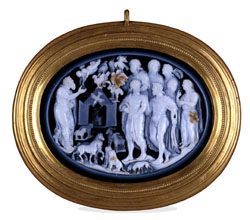
The passion for cameos was growing. They were not just collected and displayed in cabinets but also mounted in all types of jewellery - rings, pendants (Fig. 8), brooches, hat badge enseigne (frequently decorated with the wearer’s portrait, monogram, patron saint) (Fig. 9). The demand was high, and the quantity of antique cameos was not sufficient. Cameos were widely carved by modern artists. Some of them signed their works in Latin or Greek.

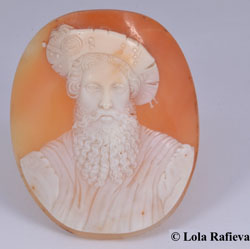
The fashion for cameos quickly spread to other countries. The Italian engravers were invited to France, England, Spain, Germany, etc. Charles IX of France, son of Catherine de Medici, created a special gallery in the Louvre for the engraved gems brought by his mother from Italy, Henry IV supported the art of gem carving and commissioned several his portraits on cameos and intaglios (Fig. 10).
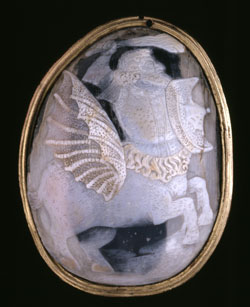
In England it was supported by Tudors. Elizabeth I commissioned several her portraits to be carved on gems that then were mounted as pendants and brooches and used “as payment to her loyal subjects for favour or for a particular service” [Anna M. Miller, 2013] (Fig. 11).
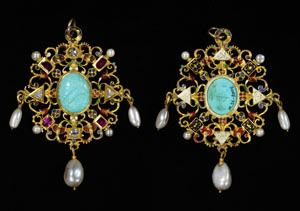
In the 16th century a new type of cameo was introduced - habille cameo, or commesso - a jewel where the metal and cameo elements merge together (Fig. 12).
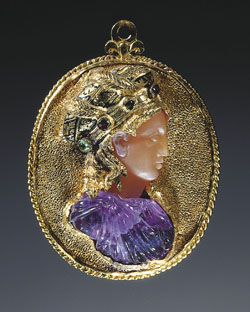
The 16th and 17th centuries are characterised by high quality gem cameos, some in a high relief. New materials were introduced. Since the demand for cameos was very high and the supply of gems was not high enough (plus it was time consuming), shells started to be used from the 16th century. These type of cameos of the 16th and 17th centuries are characterised by grey and greyish-blue backgrounds (Fig. 13). Some cameos from this period look to be carved of cowrie shell (sea snails belonging to Gastropoda class of molluscs) (Fig. 10, 14). These shell cameos are characterised by quite low relief.
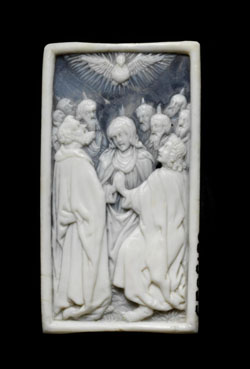
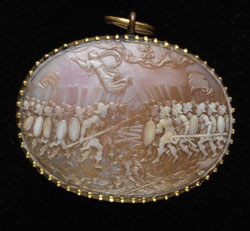
As for the stones used for carving during the 15th - 17th centuries, new types began to be widely used, such as ruby, sapphire, emerald, lapis lazuli, and turquoise. The main gems for carving were still different types of quartz - mostly agate and onyx - but also amethyst, rock crystal, and citrine. Bloodstone was frequently used for religious cameos depicting Jesus Christ (Fig. 15). The supply of gems was not always high enough, so artists frequently used intaglios to cut a cameo on the reverse side (Fig. 11) [Duffield Osborne, 1912]. Later new gem deposits in Brazil provided a source of hardstones suitable for carving.
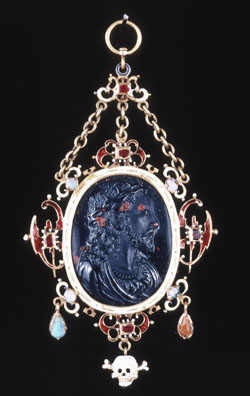
Among the main subjects of the Renaissance period we still can see classical mythological and heroic pictures from the Greek and Roman antique gems, sculptures and manuscripts. Some antique cameos were perfectly copied in this period. Religious motifs were frequently used as both ornamental (Fig. 13) and in jewellery (Fig. 15). Portraits of all possible types were widely carved - ancient Greek and Roman philosophers, Roman emperors, modern kings and queens (Fig. 10-11), etc. Pictures from everyday life or famous events were also popular (Fig. 14). Thus, gem carvers of the Renaissance didn’t completely copy previous antique gems but introduced many new ideas and used new materials.
The romanticism of the Baroque period and the lovesickness of the Century of the Dilettanti.
The late 17th and most of the 18th centuries can be called a romantic period in cameo carving. Many schools in Italy in Europe were founded at that time [Anna M. Miller, 2013]. France and Germany became two important gem carving centres with Italy still being the epicentre of this art [Duffield Osborne, 1912].
Religious motifs are very typical for the cameos of Baroque period but they were more and more overtaken by classical Greek and Roman style in the 18th century. The Pompeii and Herculaneum excavations formed and directed the Neo-Classical fashion of late 18th century European society.
Some famous collections were formed at that time such as the Duke of Marlborough’s and Russian empress Catherine the Great’s collection of gems [Anna M. Miller, 2013; Multum in Parvo, Wartski, 2019].
Another famous collection of the 18th century belonged to Baron Philipp von Stosch, a Prussian antiquarian, who spied on the Jacobites in Rome for the British Government (his pension was payed by the British until the baron’s death). It helped him to finance his quite expensive hobby. His collection included over 10,000 cameos, intaglios, and antique glass pastes. It contained many modern copies of antique gems that were carved by some famous gem engravers of the period such as Flavio Serletti and Jean Lorenz Natter. It was bought by the Prussian king Frederick the Great after the baron’s death for about 30,000 ducats and now is a part of the Berlin museums’ collection [Duffield Osborne, 1912].
Emperor Napoleon founded a school and inaugurated a special price to promote gem engraving. He also ordered to take some cameos from the Bibliothèque Nationale collection and set them in jewellery [Henry Vever, 2001]. The court jeweler Marie-Étienne Nitot made a beautiful set with shell cameos for empress Josephine that included a tiara, a necklace, a bracelet, and a pair of earrings. This set is in Swedish Royal family collection and is traditionally used as a wedding parure.
Famous and highly collectable artists of this period are Giovanni and Luigi Pichler (sons of Anton Pichler who settled in Naples in 1730 and was famous for his perfect imitation of antique carvings), Edward Burch RA, Nathaniel Marchant RA, Benedetto Pistrucci (in London he was a chief-engraver of the Royal Mint and his design “St. George Slaying the Dragon” was engraved on sovereigns in 19th-early 20th centuries) (Fig. 16), Christian Hecker and others. A good list of the artists can be found in Anna M. Miller’s book “Cameos. Old & New” and “Multum in Parvo”, Wartski [Anna M. Miller, 2013; Multum in Parvo, Wartski, 2019]. One important thing is that all these engravers signed their works. The collection of the British Museum and the Royal Collection are recommended for signature comparison (as well as other museum collections). Also valuable information about signatures can be found in the 1912 book “Engraved gems, signets, talismans and ornamental intaglios, ancient and modern” by Osborne Duffield.
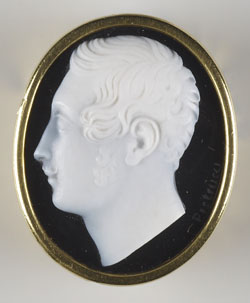
In the late 18th century mass-produced engraved gem imitations appeared on the market. The earliest were made of vitreous glass by Scottish maker James Tassie (1735-1799), who produced over 15,000 cameos and intaglios. Compared to old Roman cameos that were frequently cut, these ones were moulded. He developed the recipes and could imitate perfectly opaque and transparent gems, and cameos of different layers (Fig. 17). He became very popular and when he settled in London, he frequently exhibited at the Royal Academy [The Oxford Dictionary of Art, 2004]. Catherine the Great ordered copies of all the known engraved gems from Tassie [Anna M. Miller, 2013]. Tassie's items were catalogued and printed by Erich Raspe (he is well known for his tales about Baron Munchausen) in 1791. The photocopy version is available online from the Beazley Archive in Oxford. After James’s death his nephew William Tassie continued the business.
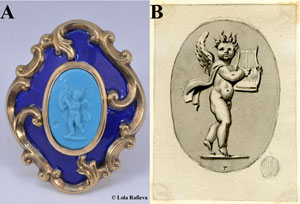
B. Drawing of the glass paste intaglio, c. 1768-1805. British Museum.
Tassie produced casts for Wedgwood, whose cameos were widely available from the late 18th century. They were so popular that other European ceramic factories, like Sevres, Berlin, Lisbon and others started to produce “cameos”.
And finally another popular type of engraved gem simulation at that period were iron casted “cameos” (Fig. 18).
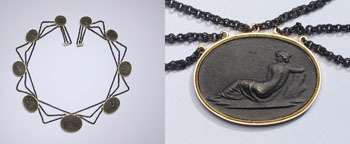
The passion for ancient style engraved gems turned into mania in the late 18th century. The demand was high, the new materials (quartz varieties from Brazil, shells from Caribbean, lava from the Mount Vesuvius) became widely available and affordable, and the art was replaced by mass-production. Not unexpectedly this lead to a lack of quality and production of many forgeries [Anna M. Miller, 2013]. Every available old work was copied and released on the market in high quantities. Sometimes antique pastes were even destroyed after copying to prevent their possible identification. “…old gems were retouched and even recut, and the names of real and even imaginary artists of antiquity were interpolated on many stones… in the second half of the 18th century the antique method of writing was so well reproduced that it is often difficult and sometimes impossible to judge from the signature alone” [Duffield Osborne, 1912].
A famous scandal around fake antique engraved gems happened with Prince Stanislas Poniatowski’s collection. Prince Poniatowski was a Polish nobleman and a member of the wealthy Poniatowski family. From his uncle, the Polish king Stanisław II Augustus, he inherited a collection of about 150 ancient Greek and Roman engraved gems, including some really rare and highly desirable ones like the bust of Io by Dioscurides [Duffield Osborne, 1912]. Over the next few years he increased the collection to almost 3000 establishing it as an antique one with “ancient” signatures! 2,601 of his gems were later catalogued and published by him in 1830s [Golyzniak, 2016]. These publications initiated rumours about possible fakes: too many gems that just can’t exist; a style in many cases that was typical for neo-classical works; the size of the gems, their finish and polishing, etc. [Anna M. Miller, 2013; Golyzniak, 2016]. After his death the collection was auctioned at Christie’s in 1839 and totally failed. Many gems were not sold at all, and the price for some rare ones was below any possible limit. For example, the rarest Io that was valued earlier for $5,000 was sold for only £17. The Pistrucci’s cameo of Augustus and Livia, for which he was paid £800, was sold for £30! The goose that had been laying so many golden eggs last years, was finally killed [Duffield Osborne, 1912]. After this scandal, the engraved gems never reached the high prices they had before the Poniatowski affair.
The majority of Poniatowski’s gems were acquired by John Tyrrell and later 1200 of them were published in 1857 and 1859 with 471 photos of plaster copies - this was one of the earliest use of photography in an art-historical publication [University of Oxford]. He spent a fortune trying to resell the gems. Also many pieces of the Poniatowski collection went to New York and were sold there with the Tiffany Company acting as an agent [Duffield Osborne, 1912; Anna M. Miller, 2013]. Thus, they spread throughout the world and may appear at auctions from time to time.
The main features of Poniatowski’s engraved gems, aside from the size and neo-classical details mentioned earlier, is an amazing variety of antique scenes from classic alhistory and mythology - most of them were inspired by Virgil’s Aeneid, and Homer’s Iliad and Odyssey. Such famous artists as Giuseppe and Pietro Girometti, Nicolo Cerbara, Tomaso Cades, Giovanni Calandrelli worked in his service [Shirley Bury, 1991; Anna M. Miller, 2013; Golyzniak, 2016]. Many of the gems were exceptional in quality! If only they have been presented as modern, the effect on the gem engraving art would be completely different. The later 19th century cameo carvers and gem engravers were frequently “inspired” by this collection and widely copied these scenes on shells, hardstones, lava and paste.
An extraordinary thing about Poniatowski collection is that it was made of oriental gems that were actually available in antiquity, not the new supply from Brazil or Germany. It makes the identification of them very difficult. Thankfully the photos and descriptions that were published by John Tyrrell aiming to promote the sale and nowadays available from the Beazley Archive in Oxford can give a clue to their identification.
The 19th century was an age of brooches; cameos stayed in fashion as a jewellery piece and as a travel souvenir of the Grand Tour. This was a period when many famous museums opened their collections to the public. Wearing a brooch depicting some famous European attraction, or a piece from a museum collection, or a portrait of popular writers and poets, was a perfect way to demonstrate to society that you are a well educated and well travelled person.
An enormous import of shells from the Caribbean and African coasts after 1830s, lava (actually a limestone) from the Mount Vesuvius area, and increasing ivory import helped to fulfil the demand for cheap and affordable cameos [Shirley Bury, 1991]. Wedgwood ceramics were still popular, and in the second half of 19th century sulphide “cameos” appeared in mass-production.
Although the cameos became much cheaper and were not as highly prised as before the 1830s there were still artists creating really beautiful sculptural pieces. Among the famous and highly collectable ones are Tommaso and Luigi Saulini (Fig. 19-20).
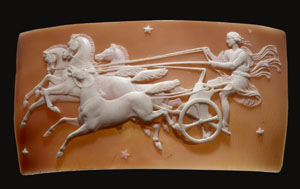
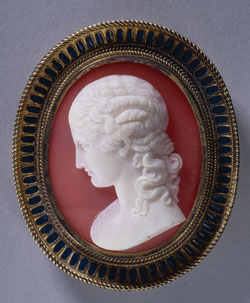
Among the subjects of the 19th century are many Greek and Roman mythological scenes, deities, nymphs and heroes (Fig. 21). The most popular ones are Medusa (Fig. 22), Cupid and Psyche, Bacchantes or Bacchus, Hebe with an Eagle (Zeus), Flora (Fig. 23), Heracles (Fig. 24), all possible putties etc. The “Nineteenth Century Cameos” book by Michele Rowan (2004) can be recommended for identification as well as all sources mentioned above.
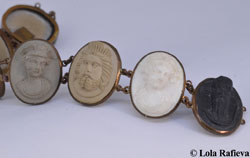
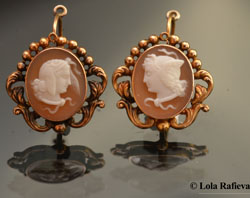
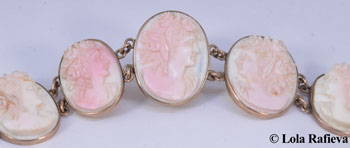
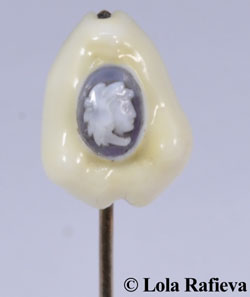
Many different copies and interpretations of 15th-19th centuries art pieces can also be seen on the 19th century cameos, such as Raphael (his “Madonna of the Chair” is among the most popular), Michelangelo, Botticelli, Guido Reni (“Angel of Annunciation” as well as “Aurora” were highly reproduced on cameos) (Fig. 25), Bertel Thorvaldsen (“The Day” and “The Night” can frequently be seen) (Fig. 26), Antonio Canova (all his sculptures from the British Museums were reproduced), John Gibson (“Venus and Cupid”, “Cupid and Psyche” and others), John Flaxman and many others.
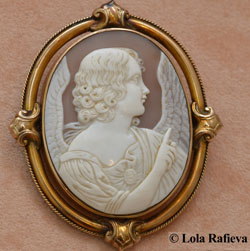
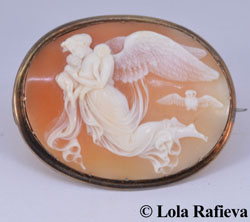
Portraits were also popular as in all previous periods: Roman emperors, Mary Stuart, Elizabeth I, Dante Alighieri, Byron and Shakespeare, Michelangelo, Leonardo da Vinci, and many others.
The new pictures of this period are possibly all types of pastorales with shepherds, they were an interpretation of 18th and 19th century paintings.
Among the biblical scenes “Rebecca at the Well” is probably the most common (Fig.27). Most of them are of very poor quality and usually include a female figure at the well or on a road (supposed to be on her way to the well). All these are typical for mid - late 19th century and usually seen on shells.
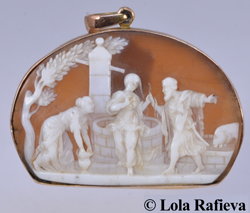
Among the popular materials of this period are Gastropod molluscs shells - Cassis madagascariensis (sardonyx, or queen helmet, sometimes also called black helmet) (Fig. 27), Cassis cornuta (horned helmet), Cypraecassis rufa (carnelian, or bullmouth shell) (Fig. 9, 26), Strombus gigas (Queen conch, or pink shell) Fig. 23). Cowrie shell was also used but less frequently (Fig. 24). Lava of many different colours (Fig. 21), corals, ivory and tortoiseshell were widely used after 1840; jet cameos - after 1860. Among imitations, vitreous glass (very frequently doublets), sulphide “cameos” and Wedgwood ceramics are frequently seen. Plastics and different jet imitations (like vulcanite) appeared after 1870.
Cameos of 19th century were usually carved in high relief, their size is bigger compared to previous centuries. After 1850 shell cameos are frequently carved in large sizes as well.
Summary
The art of cameo carving fell into decay by the end of 19th century. From the artists of the 20th century, Giovanni Noto is probably the most famous and collectable. After hardstone dominance through history shell became the main material from the late 19th century, and the 20th century became an era of plastic imitations. One could think that the cameo as a part of art is lost forever but it is very good to see that in the last 10 years the demand for hand carved cameos is increasing, and not just antique ones but also modern. Every year artists working in this type of art can be seen at different gem fairs and exhibitions (Tucson, USA; IJL, London, etc.).
At the same time there is a demand for antique cameos. Most of the engraved gems that can be found on the market today are from the 19th and late 18th century, although Renaissance and Roman gems appear from time to time.
As you could see through the whole history there always were copies, reproductions and deliberate forgeries. When you analyse a cameo as any other antique piece, you have to take all the details into account.
The material of the cameo - whether it is soft or hard stone, its origin, type of shell, coral, ivory or lava, carved or a moulded glass. Roman cameos were mostly carved of the hardstones of Oriental origin. German agates were dominant from approximately the 11th to 18th centuries. In the Renaissance many new gems such as turquoise, emerald and corundum were used. Shells as a material appeared in the 16th century. Until approximately the middle of the 18th century shell cameos are very flat with a low relief, mostly with a grey or bluish-grey background, some cowrie shell can be seen (their distinguishing feature is that they have seven colour layers, no other type of shell is the same). Since the mid-18th century different types of Cassidae and Strombidae family shells are used. They have brown, orange and pink colours and are usually carved in high relief. Coral, tortoiseshell and ivory cameos are becoming more common on the market from 1840. Glass (paste) cameos before the late 18th century were carved and after the 19th century all glass cameos were produced from moulded glass.
Although the techniques and tools used for carving have hardly changed since old times it is important to find undercut features to be able to distinguish hand carved cameos from the modern machine-made ones. The polishing on hardstone cameos sometimes can give some clues in identification and dating.
The style of the cameo is very important. As you could see in the story of the Poniatowski gems this was one of the main clues. Fashion is changing all the time, and art is changing in parallel. All 20th centuries cameos have people with slightly snub nose compare to straight Roman noses typical in previous centuries. The whole face features in 20th century becoming more curly and lighter than before. The details of clothing or jewellery depicted on a cameo can also give a clue: they have to match the period.
In the case of cameos the size matters. Roman cameos worn as jewellery were of small sizes. For Renaissance gems this is also true because the gemstone supply wasn’t enough yet, and many stones were highly valued. Shell cameos until approximately 1840 were either small or medium sizes. Large size cameo brooches appear after 1840 and became especially fashionable after 1860. Before that shell cameos of 2.5-3 inches were mostly seen in a belt or hair ornaments.
Although gems were remounted all the time during the history, if you can identify and date the mount it also may help you to identify and date a cameo - at least it gives you the latest possible time. Sometimes it is also useful.
The current review is aimed to help to understand the main clues of cameo nature and identification. The cameo addicted collector says that you have to have a feeling for it. If you work with cameos for years, you can tell and date the piece with closed eyes, it talks to you. This is true, but constantly improving your knowledge, keeping an eye on all new techniques and methods, together with logic can be good friends in this journey, no matter whether you are a valuer, a dealer or a collector.
References
- Beazley Archive, University of Oxford. https://www.beazley.ox.ac.uk/gems/poniatowski/default.htm]
- Bury, S. (1991). Jewellery. 1789-1910. The International Era. Volume I. 1789-1861. Antique Collectors’ Club Ltd.
- Draper, J.D. (2008) Cameo Appearances. Metropolitan Museum of Art.
- Duffield, O (1912) Engraved gems, signets, talismans and ornamental intaglios, ancient and modern. New York, H. Holt and company.
- Golyzniak, P. (2016) The Impact of the Poniatowski Gems on Later Gem Engraving. Studies in Ancient Art and Civilization. Jagiellonian University, pp. 173-192.
- Jewellery Through 7000 Years. 1976. The Trusties of the British Museum
- Miller, A.M. (2013) Cameos. Old & New. GemStone Press; 4th Edition.
- Multum in Parvo. Wartski. 2019.
- The Oxford Dictionary of Art. https://books.google.co.uk/books?id=WYaRX58a0_IC&dq=tassie+reproduction+of+gems+ancient+and+modern&source=gbs_navlinks_s
- Rowan, M. (2004). Nineteenth Century Cameos. Antique Collectors’ Club Ltd.
- Vever, H. (2001) French Jewellery of the Nineteenth Century. Thames & Hudson.
About the Author
Lola Rafieva PhD, FGA, DGA, a member of the JVA, and appraiser and gemmologist at Bentley & Skinner. Lola has been in the antique jewellery business since 2014. A scientist by training, she has strong analytical skills and a good eye for detail.
